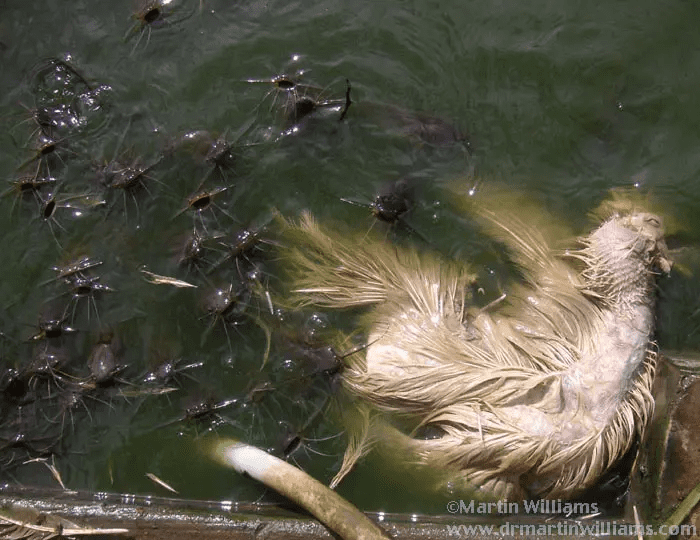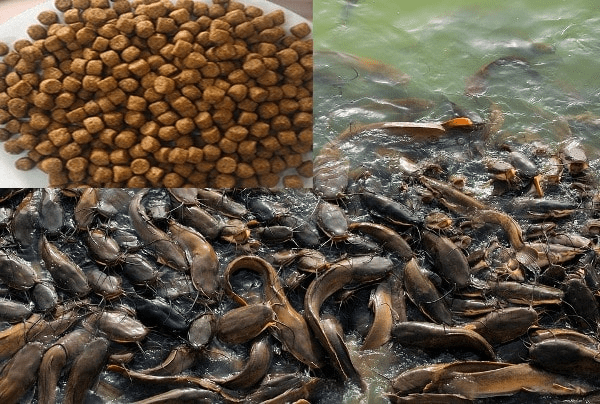Some catfish farmers often ask questions like: Please I was told that I can dump dead animals in my pond for my catfishes to consume. Is it ideal? Well, dumping dead animals in your fish pond is a very good way of contaminating your pond. Truly, some part of the animal will be consumed by your fish, but the remnant will decay and contaminate your pond.
Also, this is another way of introducing disease to your fish since you don’t know the cause of the death of the animal and even if you know, you don’t know the health status of the animal before it death.
So, it is not advisable to throw dead animals into your pond. If at all you must give any animal to your fish, make sure the carcass is fresh and boiled before serving your fish.
A Good Way to Feed Catfish

In catfish farming or any other type of fish farming, feeding is one of the most important things. Some people may think that feed catfish is simply throwing the feed to the pool, but that is not true. Although it may seem easy and simple, there are many things to be considered if you want the catfish to grow well and thriving.
1. Size of feed
In general, catfish feeding should be based on how old or how big your catfishes are. There are many sizes of catfish feed available, so it shouldn’t be too hard to find one that suitable with your catfish size. When the catfish get bigger, you can feed them with a bigger food size.
When you are able to grow really big fishes, for example when your catfishes reach 1kg in weight or more, you can consider the 8 or 10 mm feed sizes. It will be more practical and easier to feed, but if you cannot find a bigger feed, the regular one should be fine.
2. Feeding frequency
Just like how the feed size matters in feeding the fish, you should also pay attention to how often you feed them. Different stages of growth require a different frequency of feeding too.
Fingerlings of 3–4 grams weight should be fed twice per day. When they reach the post-fingerlings and juvenile stage, you can keep feeding them twice a day or reduce it to once a day. Next, after they reach the post-juvenile or above that, you can reduce the feeding frequency to once a day.
3. Type of catfish feed
What do catfish eat is a common question to ask for a beginner in fish farming. Basically, you can get any type of catfish feed on any fish store around your area. Some bigger store even has organic fish food that is good for your fish’s growth. Give your catfish an adequate amount of protein to keep them growing well.
Aside from different sizes, there are also floating feed and sinking feed. The floating feed is those that keep floating after you spread them in water, while the sinking feed is those that immediately sink after you throw them into the water.
The floating one is good for the smaller size of fishes like the fingerlings or the juveniles stage. While the sinking one is better for bigger fish as they are naturally bottom feeders.
Read Also: How to know if your Catfishes are Underfed or Overfed
4. Catfish nutrition
To yield good production for the harvest, you need to pay attention to the nutrition you give to the fishes. While ready to fed catfish feed is usually packed with nutrition, you can also give them more natural feed like duckweed, for example. Duckweed is known as a great fish feed and is commonly incorporated in fish farming. But how much duckweed to feed catfish is good enough?
Duckweed has been known for its high nutrition content. It also contains a high concentration of amino acids, methionine, and lysine which is good for the growth of the fishes. You can feed them with duckweed as an alternative source of food for them.
5. How much do you feed the catfish?
The portion is also things to consider when you feed catfish. It is obvious that lack of feeding will hinder the growth of your catfishes and may make them appear smaller than the size they should be in respect of their age.
Additionally, you should also be careful not to overfeed them. However, understanding whether your catfish is already satiated may not be easy for beginner catfish farmers.
To understand whether your fishes are well-fed or not, you have to observe them carefully. When you are using the floating feed type, it should be easier because you only have to make sure that there is no excess feed on the surface of the water.
Floating feeding should be finished within 5 minutes after you stopped feeding the fishes. When it is more than that, it will be probably just going to be a waste and you should not add more feed.
For the sinking feed type, you need to observe the response that your fishes have. When they respond actively and eagerly when you feed catfish, it’s most definitely that they are hungry. When the reaction reduced and they become calm, it means that they start to feel full. Another sign is that the fishes are not popping their heads out of the water.
Every fish farmers need proper knowledge of how to feed catfish. It goes beyond spreading the fishes feed only, but also considering their nutritional needs and the surrounding conditions. Well-fed and stress-free catfishes will be able to grow healthily and thrive. This will result in good production results which will lead to profitable business for catfish farmers.
Feed represents the largest variable cost in catfish production. While the need for more economical feeds is clear, it is imperative that catfish feeds are formulated to be cost-effective, not just less costly. This can be achieved by carefully selecting and blending various traditional and alternative feedstuffs that are suitable for use in catfish feeds.
It is important that using less expensive alternative feedstuffs not degrade the nutritional and physical quality of the feed, fish growth, processed yield, and product quality.
Feed Ingredients for Catfishes

Commercial catfish feeds are a mixture of feedstuffs and vitamin and mineral supplements that provide adequate amounts of essential nutrients and digestible energy.
To be suitable, dietary ingredients must be highly digestible, easily handled in the manufacturing process, able to withstand the rigors of the manufacturing process, available on a consistent basis, economical, and contain sufficient nutrients.
Although all feedstuffs contain energy, protein, and other nutrients, they are usually classified as either protein or energy feedstuffs. In animal feeds, those containing 20 percent protein or more are generally referred as protein feedstuffs, and those containing less than 20 percent protein are energy feedstuffs.
Protein feedstuffs are further divided by the source, either animal or plant. There are many feedstuffs that may be nutritionally suitable for use in catfish feeds, but relatively few are readily available on a timely basis and at reasonable cost. Although we will consider all types of feedstuffs, we will focus mostly on protein feedstuffs, as protein is the most costly fraction of catfish feeds.
Read Also: Methods of Livestock Breeding in the Tropical Environment

Good one….thanks very much
Smiles… glad I could help
very insightful.
thanks for this
Thank you so much and we are glad that you find our article very helpful